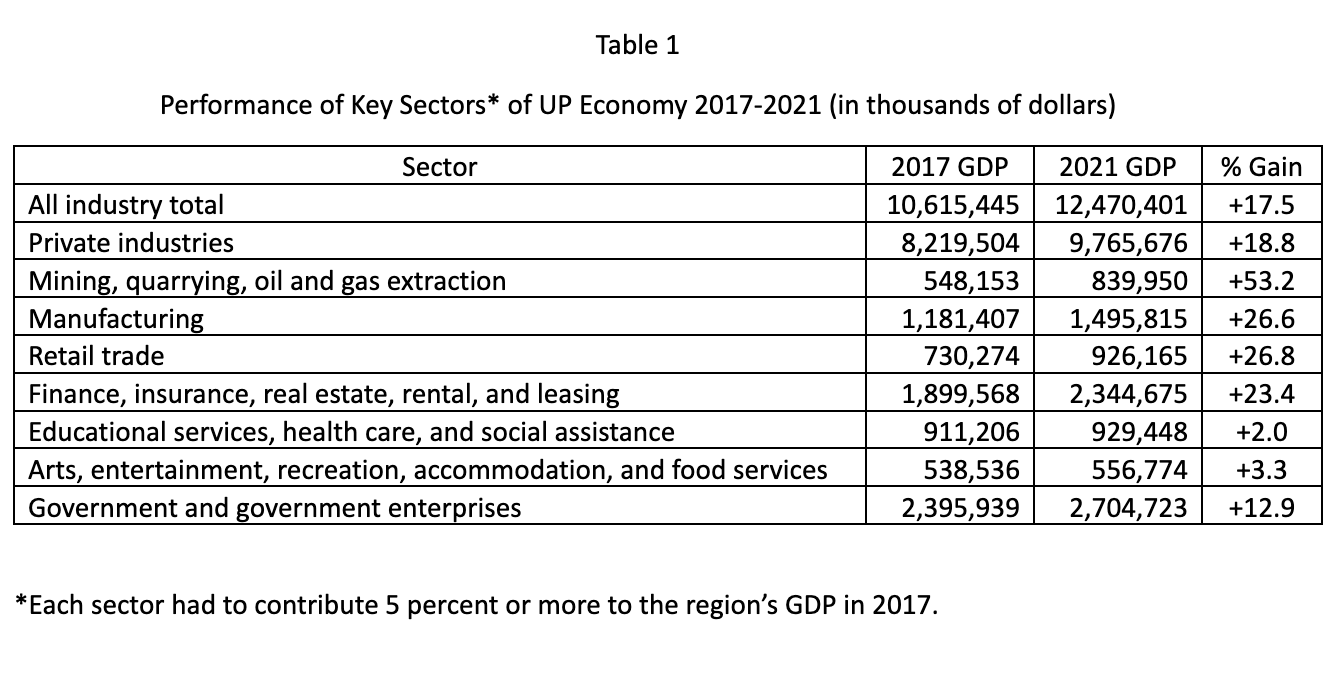Changes in the UP Economy: 2017-2021

Among the many statistics used to describe a country’s economic performance is the Gross Domestic Product (GDP).
An increase in GDP, generally speaking, is a sign that the economy is doing well. It measures the total market value of the goods and services produced within a territory. Goods are considered things that people make, grow, or extract from the land, while services are actions that people do for someone else, such as a dental check-up or computer repair.
This article examines recent changes in the Upper Peninsula’s GDP in the aftermath of Covid-19 to determine which sectors of its economy are growing and which are underperforming.
Key Sectors
The GDP data for each of the 15 UP counties were combined, and the major sectors in terms of their contribution to the UP’s GDP in 2017 are summarized in Table 1. The largest single sector is government services, at 22 percent. This is a high figure relative to other Michigan counties; the corresponding figure in Ottawa county, in southwest Michigan (with the same population as the UP), is 9 percent. The UP’s high figure attests to the numerous federal, state and local government employees in the region.
The next largest sectors are finance insurance, real estate, rentals and leasing (18%), manufacturing (11%) educational services, health care and social services (9%) and retail trade (7%). Together they accounted for over two-thirds of the region’s GDP in 2017. Other important contributors include mining (5%) and the arts, entertainment and hospitality sectors (5%).
Growth in GDP
Between 2017 and 2021 the UP’s GDP increased by 17.5 percent, which exceeded the state’s figure of 12.2 percent. The region’s higher growth rate belies the common narrative about rural areas lagging behind urban areas. Among the region’s key sectors – mining, manufacturing, retail and finance, insurance, real estate and leasing – all exceeded the UP GDP growth rate. Increasing commodity prices for iron ore and nickel are responsible for the 53 percent rise in the value of mining’s output, while an expanding economy is behind retail and manufacturing’s increase. Growth in the real estate sector is driven by rising real estate values.
According to an analysis of Marquette and Northern Coastal Marquette County conducted for the state’s 2022 Housing Plan, the limited housing supply has driven up home values. As a result, the rental and leasing sector’s contribution to GDP increased. The importance of this sector to the region’s economy cannot be underestimated: in Alger County, another north shore location, it accounts for 22% of the county’s GDP, while in Ontonagon, on the west end of Lake Superior, it accounts for 38%. Tiny Keweenaw County has the highest percentage at 44%.
‘Eds and Meds’
Educational and health care services along with the arts, entertainment and hospitality sectors experienced minimal growth. In the past, many rural communities have pursued a so-called ‘eds and meds’ economic development strategy, relying upon a steady income from higher education and the health care sector to support local businesses. But declining student enrollment and consolidation in the health care sector means that this is no longer a viable strategy.
The announced closure of Finlandia University in Hancock is illustrative. In 2011 over 600 students were enrolled at the institution, but a decade later the number dropped to just over 400. With no students this coming fall, and the loss of an annual payroll of $1.6 million for instructional staff, Finlandia’s closure is sure to have a negative impact on the Hancock area. In Marquette County, efforts to balance NMU’s budget in line with falling tuition revenue resulted in a $7 million reduction in its operating expenses from 2020 to 2021, mostly in the form of lower instruction and student support expenditures.
Declining student enrollment and consolidation in the health care industry are nationwide issues. Rural hospitals typically have greater shares of poor and elderly residents, which drives up the number of patients insured by Medicaid and Medicare, whose reimbursement rates are lower than commercial insurance. With less income, hospitals often end up cutting services and laying off people. In Sault Ste. Marie, Chippewa County War Memorial Hospital imposed a 10 percent pay cut on employees, in 2014 and again in 2018 as well as eliminating 80 jobs. In 2021, the hospital announced a merger with MyMichigan Health.
The Federal Reserve Bank of Philadelphia has an online tool for measuring how different regions are dependent upon ‘eds and meds,’ according to which the Upper Peninsula, with its 11 higher education institutions (before Finlandia closed), and 21 hospitals, is overly reliant on these sectors compared to the country as a whole.
The hospitality sector was hit hard by Covid, and its 2021 output is only up by 3 percent from 2017. There are two notable exceptions to this pattern: Alger and Ontonagon counties. Alger is home to Pictured Rocks National Lakeshore, which saw its attendance shoot up by over half a million from 2017 to a record 1.3 million visitors in 2021. On the UP’s west end, Porcupine State Park’s visitor numbers more than doubled between 2017 and 2021 to exceed 600,000. Increased tourist numbers resulted in a 30 percent gain in Ontonagon’s arts, entertainment, recreation, accommodation, and food services’ output.
Conclusions
First, the good news: the UP’s rate of GDP growth exceeded the state’s figure. The bad news is that historic mainstays of the economy, ‘eds and meds’ and the hospitality sector, experienced minimal growth. Tourists are particularly fickle. A year after Pictured Rocks record visitation in 2021, numbers fell by close to 400,000. Fewer visitors mean less money for tourist-related businesses.
Looking ahead, it is critical for the region’s future to expand other sectors beyond resource-based industries and real estate. ‘It is an ill wind that blows nobody good,’ since rising housing costs have translated into a large increase in the rental and leasing sector’s GDP but also made finding affordable housing difficult which will, in all likelihood, hamper economic development efforts over the long term.








Fascinating.
Interesting snapshot of the U P economy. Thank you for your efforts.
I am worried about health care nationally and in rural regions particularly. I firmly believe that our for-profit system is getting out of control and that we need to consider seriously a single payer system that will drive costs down which should stimulate our rural economies. Small businesses are not able to afford health insurance for their workers. They lose workers who often leave to find larger employers who can provide health care (or better health care). When you have for-profit health care, revenues leave the region and go to executive pay and wall street. Under a Medicare for All system, we would have global budgeting that would ensure enough revenues in different rural regions. There would be no “middlemen” insurers standing between doctors and their patients. Businesses in the UP need to rethink the whole system and demand a single payer system in place of what we have now. Health dollars should be going to more health care workers, not to salaries of private sector administrators who contribute nothing to the advancement of health care.
Very interesting report. Thanks
My assumption would have been tourism a higher percentage of gdp. On Drummond Island increase in Jeep and ATV tourism has been a mixed blessing with more money coming in but concerns by residents about noise, environmental damage.
“The largest single sector is government services, at 22 percent. This is a high figure relative to other Michigan counties; the corresponding figure in Ottawa county, in southwest Michigan (with the same population as the UP), is 9 percent. The UP’s high figure attests to the numerous federal, state and local government employees in the region.”
Doesn’t this point to the inefficient political structures and organization of the UP: Too many counties, too many other little units of government and quasi government activities, duplicating efforts and dividing the focus and effort. Cut the number of units in half and spend the savings on economic development and improving the labor force numbers. And efficiencies in health care organization and distribution will yield more savings as well. And hey, I am not an anti-government type.
Economic growth in an area that is largely tribal treaty ceded territory that tribal members have subsistance rights to isn’t a good thing. We’re seeing our first algae blooms in Lake Superior. Economic growth is not necessarily a public good.
According to the Bureau of Labor Statistics consumer price index from 2017-2021 the cumulative inflation rate was 23.1% so anything less than that you are losing ground. Even though we did better than the rest of Michigan we still loss ground, didn’t we?
My summary is we aren’t don’t well and until private indusries do well we are in trouble.
Looking at the sector of GPD growth
• Private Industries (78% off the total GDP) didn’t keep up with inflation over the last the last five years. This is the most importatn sector and we must do better to IMPROVE.
• Government services, (22%). Is growth in this area a good sign?
• Finance insurance, real estate, rentals and leasing (18%). Is the cost of housing, rent, and leasing a positive thing for the UP or a sign of a hosuing shortage?
• Manufacturing (11%). Yep I think all positive but barely kept up to inflation and accounts for only 11% of our income.
• Educational services, health care and social services (9%). Hard to assess since education and health care are fundamental to everyone well-being. The greater the cost the worse for all of us. But this also reflect loss of local services which is a bad thing.
• Retail trade (7%). Holding our ground
• Mining (5%) Great improvement but unfortunately a small overall percentage of our economy
• Arts, entertainment and hospitality sectors (5%). Improvement not good at all.
Corrected version with spell check. Sorry
According to the Bureau of Labor Statistics consumer price index from 2017-2021, the cumulative inflation rate was 23.1%, so anything less than that, you are losing ground. So even though we did better than the rest of Michigan, we still lost ground, didn’t we?
I summarize that we aren’t doing well, and we are in trouble until private industries improve.
Looking at the sector of GPD growth
• Private Industries (78% of the total GDP) didn’t keep up with inflation over the last five years. Yet, this is the most critical sector, and we must do better to IMPROVE.
• Government services (22%). Is growth in this area a good sign?
• Finance insurance, real estate, rentals and leasing (18%). Is the cost of housing, rent, and leasing a positive thing for the UP or a sign of a housing shortage?
• Manufacturing (11%). Yep, I think all positive, but we barely kept up with inflation, accounting for only 11% of our income.
• Educational services, health care, and social services (9%). Hard to assess since education and health care are fundamental to everyone’s well-being. The greater the cost, the worse for all of us. But this also reflects a loss of local services, which is terrible.
• Retail trade (7%). Holding our ground
• Mining (5%) is a Great improvement but, unfortunately, a small overall percentage of our economy
• Arts, entertainment, and hospitality sectors (5%). Improvement is not good at all.